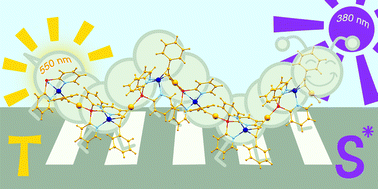Luminescence behaviour of Au(i)–Cu(i) heterobimetallic coordination polymers based on alkynyl-tris(2-pyridyl)phosphine Au(i) complexes†
Abstract
A set of alkynyl-tris(2-pyridyl)phosphine Au(I) complexes was synthesized and characterized. Free coordination functions on the ligand environment periphery, namely ‘scorpionate’ PPy3 and the C![[triple bond, length as m-dash]](https://www.rsc.org/images/entities/char_e002.gif) C bond, allowed these ditopic metalloligands to be selectively linked to 1D coordination polymers by reaction with Cu(I), which used both Cu–(N-PPy3) and Cu–(η2-C
C bond, allowed these ditopic metalloligands to be selectively linked to 1D coordination polymers by reaction with Cu(I), which used both Cu–(N-PPy3) and Cu–(η2-C![[triple bond, length as m-dash]](https://www.rsc.org/images/entities/char_e002.gif) C) coordination modes. Single-crystal and powder XRD, NMR, and XPS techniques were used to characterize the coordination polymers obtained. Heterobimetallic Au(I)–Cu(I) coordination polymers demonstrate triplet photoluminescence which was studied by spectroscopic and computational methods to understand the pathway of energy transfer inside the chain of linked chromophore centres. The intriguing feature of the electronic structure of heterobimetallic supramolecular assemblies is the ‘long-distance’ electronic transition involving PhC2 and PPy3 ligands located at a distance of more than 1 nm from each other. Thus, the assembly of a heterobimetallic coordination polymer from relatively simple ‘building blocks’ retains the block-wise nature of the electronic structure, but the photophysical properties of the polymer are fundamentally different from the properties of discrete organometallic components.
C) coordination modes. Single-crystal and powder XRD, NMR, and XPS techniques were used to characterize the coordination polymers obtained. Heterobimetallic Au(I)–Cu(I) coordination polymers demonstrate triplet photoluminescence which was studied by spectroscopic and computational methods to understand the pathway of energy transfer inside the chain of linked chromophore centres. The intriguing feature of the electronic structure of heterobimetallic supramolecular assemblies is the ‘long-distance’ electronic transition involving PhC2 and PPy3 ligands located at a distance of more than 1 nm from each other. Thus, the assembly of a heterobimetallic coordination polymer from relatively simple ‘building blocks’ retains the block-wise nature of the electronic structure, but the photophysical properties of the polymer are fundamentally different from the properties of discrete organometallic components.



 Please wait while we load your content...
Please wait while we load your content...